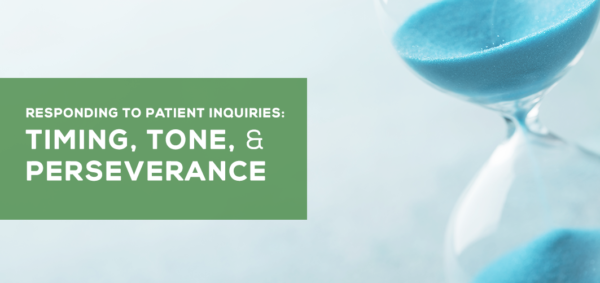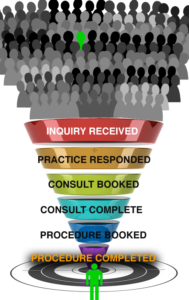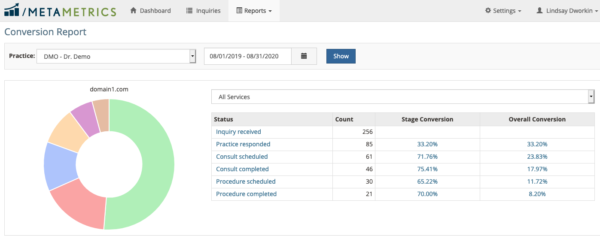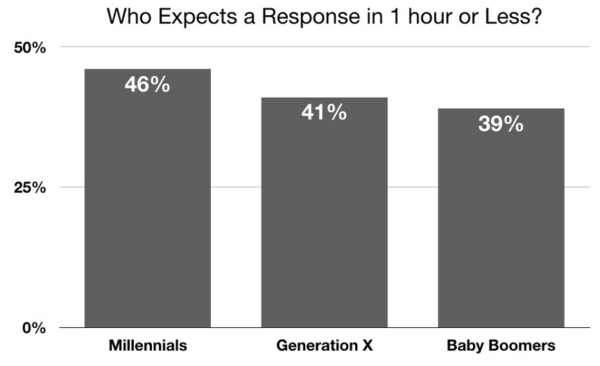
There’s a very good reason why MetaMed Marketing encourages our practices to track their various phases of closing an inquiry, from inquiry to completed procedure. There are a million factors that influence exactly how many patients progress fully through your in-office conversion funnel, but many are within your control. By collecting and analyzing data from each of these phases in the patient acquisition funnel, we can often pinpoint potential problem areas and make suggestions on how to improve retention through each stage.
PRO-TIP: MetaMed’s clients can use Conversion Reporting, which is a built-in feature of MetaMetrics (performance tracking software) to carefully track your closing rates through each phase. Learn more here.
In this post, we’ll explore the first phase of patient contact and how your response time directly correlates to your closing rates, as well as how many of those initial inquiries are translating into procedures. This is important because your marketing dollars are used for packing the highest level of your funnel and making sure the highest number of potential patients make it through to the end, helping to maximize your return on that investment.
“LEAD RESPONSE TIME”
Lead response time is a classic metric that affects almost all industries when it comes to any type of sales-driven business. It gauges how long the business takes to respond to a lead who has contacted them. For medical practices, this would be inquiries sent by potential patients for services, either by phone, email, social media, or filling out a form on your website.
Why Your Response Time Matters
Before the digital age, it was perfectly acceptable for businesses to take days to respond to inquiries, but this is no longer the case. Potential patients want a reply within 24 hours, and that number is even shorter for the Millennial market, which has become accustomed to instant online gratification. If a practice takes too long, the potential patient will find another practice for help. Most often, we’re seeing potential patients simultaneously reaching out to multiple practices in their local area, and it’s often the one that responds soonest—and with the best quality of information—that ends up booking the consultation with the patient. In 2014, one study showed that 50 percent of consumers select the vendor that replied to them first (source: https://www.xant.ai/resources/2014-lead-response-report/ ).
Industry-Specific Response Times
For obvious reasons, lead response time standards differ between industries. Here, we’ll look at a few studies that have been conducted with both general consumers and healthcare-specific consumers:
- In 2018, a popular medical leads company looked at statistics for 11 elective medical practices over two years, in combination with leads that came to practices via RealSelf.com.
- The average response time was five hours and 48 minutes.
- Calling a lead within 21 minutes resulted in a 65 percent higher lead-to consultation conversion rate (compared to those practices that took three hours).
*The overall conversion rate of RealSelf leads was low: 15 percent. This perhaps points to lead-quality issues in that particular source.
- In 2014, the general healthcare industry segment took an average of two hours, five minutes to respond to a lead. It’s important to note that for this study, auto-replies (like email auto-responders) were not counted as first contact (only phone calls).
- From a customer service perspective, a 2017 study noted that 43 percent of customers were satisfied with their email interactions with a company, and speed was selected as the highest factor in that feeling of fulfillment (source: https://www.niceincontact.com/call-center-resourcefinder/2017-incontact-cx-transformation-benchmark-study-business-wave ).
- A 2018 study (1,200 consumers; non-industry specific) showed that 43 percent of consumers expect an email response within one day, with the next largest grouping at 19 percent expecting a reply within an hour (source: https://www.toistersolutions.com/blog/2018/4/15/howfast-should-a-business-respond-to-an-email ).
SOCIAL MEDIA – The 2018 study also looked at those reaching out by social media.
- Twitter: 93 percent of consumers expected a response within one day. Of that group, 27 percent expected to hear back within the hour.
- Facebook: Again, 93 percent expected a reply within 24 hours, with 25 percent of those expecting a response within the hour. Demographics by age are reflected in the chart below for the Facebook portion of the study:
Luckily, there are many available methods of shaving valuable hours off your current response time.
- Autoresponders: There are automated email responses triggered immediately when an email inquiry is sent. MetaMed regularly custom designs these for website email forms to:
- greet potential patients warmly in your brand’s voice and graphics.
- offer further information about their procedure of interest.
- provide deeper entry points to get to know the doctors and their credentials on the website, social media, and YouTube in the meantime before human contact from the practice.
- Call-Centers: Having a 24-hour call center to have real people take incoming leads and get them to your team as soon as possible can help potential patients feel taken care of with immediacy. Remember that it’s important to vet the quality of such services, especially if operations are handled overseas.
- Marketing automation in combination with a CRM system: This removes the humanreview time from first contact and drives organized and documented follow-up action with your staff.
Besides these options, many practice administrators set a standard or expectation with their patient care coordinators for a maximum response time, as a grass-roots effort decreases waiting times. Some even encourage friendly competition structured around rewards for the staff member with the best time and closing rates on booking consultations each month.
PERSONALITY, VOICE, & TONE
In any first contact with a potential patient, regardless of whether it’s by email or phone, the tone used by your patient care coordinators is the first impression your practice gets to make and is going to be a major factor in conversion and booking the consult. Your voice and the voice of your brand should be well established within boundaries and regularly monitored in the way it’s delivered by your staff:
- It should never feel high-pressure, aggressive. or salesy, and care should be taken to talk with or to the person vs. at them.
- The first staff member to greet a lead should be able to communicate warmth of personality, without appearing too casual, and should express enthusiasm for the procedure or personal journey the person might be embarking on. Form bonds.
- Potential points of anxiety for patients should be actively addressed to help mitigate inquiry-abandonment, instead of guessing about what the patient wants to hear about your practice or what you perceive to be your USPs (unique selling propositions).
- Make sure emails use “memory darts” or written content targeted to stay in the minds of those who read it, so that you stay memorable over your competition.
- Make sure potential patients can be supplied with satisfying answers regarding your practice’s vision, mission, values, credentials, and track record if requested of your staff.
- Make sure your website also reflects your brand in these ways. (MetaMed can help!)
Attitude is Everything
To carry out a case study, MetaMed worked to help one practice that was having trouble closing bookings for a popular non-surgical body contouring procedure. While the practice was receiving lots of inquiries and booking lots of consults, we saw a sharp drop in retention of potential patients from consult to booked service. Armed with this data, the practice decided to audit the quality of the consults using secret shoppers and found that their patient care coordinator was not a fan of the procedure. This coordinator’s inability to hide a lack of enthusiasm was being transferred during the consultation to the patient leads. This was considerably hurting the future of the potential sale.
FOLLOW-UP & FREQUENCY
In the aforementioned 2018 elective-medical-leads-study, it was discovered that most practices were following up an average of 2.3 times before giving up on a lead. However, it has been shown that having at least three touchpoints helps conversions considerably (a greater-than-45-percent boost). It’s even recommended to make up to seven follow-ups. This may seem like a lot, but consider that at least three of those touchpoints should be diversified by channel—done via SMS/text, email, and phone call). You may also wish to look into using “dripcampaigns” or lead-nurturing to retain even more leads (providing continued relevant content to leads for specific procedures, like targeted email marketing).
Practices are often surprised to find out exactly how many leads they received in any given period, when compared to how many actual patients came through the doors—and the billing department. Using conversion tracking, MetaMed can help you begin to compare your practice’s performance against national industry benchmarks and derive actionable insights on where improvements can be made. When it comes to responding to leads, the age-old advice is still sound: The early bird will always get the worm. It may be time to assess how well your inoffice conversion workflow is doing for your practice.
[includeme file=”includes/lindsay-dworkin-post-img.php”]

Lindsay Dworkin
Lindsay Dworkin is an account manager at MetaMed handling creative aspects and administration of web development projects and online marketing campaigns for her clients.






